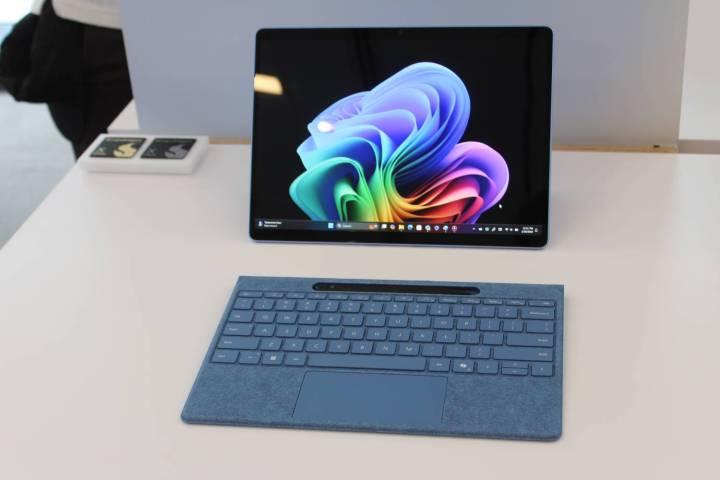
Coincidentally or not, the two most important tablets of 2024 were announced within a couple of weeks of each other. First was the updated Apple iPad Pro, which was announced on May 7, 2024, and began shipping on May 15, 2024. Then, on May 20, 2024, a radically new Microsoft Surface Pro was announced and is expected to ship in June, 2024, carrying Microsoft’s new Copilot+ designation.
The iPad Pro received Apple’s latest Silicon chipset, the M4, along with a new tandem OLED display. The Surface Pro will be shipping exclusively with Qualcomm’s Snapdragon X Elite and Windows on ARM. It, too, offers a new OLED display. Which of these two new tablets is right for you?
Specs and configurations
| Microsoft Surface Pro | Apple iPad Pro M4 | |
| Dimensions | 11.3 inches x 8.2 inches x 0.37 inches | 11-inch: 9.83 inches x 6.99 inches x 0.21 inches 13-inch: 11.09 inches x 8.48 inches x 0.20 inches |
| Weight | 1.97 pounds (tablet only) | 11-inch: 0.98 pounds 13-inch: 1.28 pounds |
| Processor | Qualcomm Snapdragon X Plus (10-core) Qualcomm Snapdragon X Elite (12-core) |
Apple M4 (9-core) Apple M4 (10-core) |
| Graphics | Qualcomm Adreno | Apple M4 (10-core) |
| RAM | 16GB 32GB |
8GB 16GB |
| Display | 13.o-inch 3:2 2.8K (2880 x 1920) IPS, 120Hz 13.0-inch 3:2 2.8K (2880 x 1920) OLED, 120Hz |
11.0-inch 4:3 2420 x 1668 tandem OLED, 120Hz 13.0-inch 4:3 2752 x 2064 tandem OLED, 120Hz |
| Storage | 256GB SSD 512GB SSD 1TB SSD |
256GB 512GB 1TB 2TB |
| Touch | Yes | Yes |
| Ports | 2 x USB4 with Thundrebolt 4 Surface Connect NanoSIM |
1 x USB-C with Thunderbolt 4 |
| Wireless | Wi-Fi 7 and Bluetooth 5.4 Optional 5G |
Wi-Fi 6E and Bluetooth 5.3 Optional 5G |
| Webcam | 1440p front-facing with infrared camera for Windows 11 Hello 10.5MP rear-facing |
1080p front facing with Face ID 12MP rear-facing |
| Operating system | Windows 11 | iPadOS 17.5.1 |
| Battery | IPS: 48 watt-hour OLED: 53 watt-hour |
11-inch: 31.29 watt-hour 13-inch: 38.99 watt-hour |
| Price | $1,000+ | $1,000+ |
| Rating | Not reviewed | Not reviewed |
The Surface Pro and iPad Pro both start at $1,000. However, the configurations offered are very different at that price.
There are two versions of the Surface Pro with either a 13.0-inch LCD display or an OLED panel. The LCD version starts at $1,000 for a Qualcomm Snapdragon X Plus, 16GB of RAM, and a 256GB SSD. It can be upgraded to 512GB for an extra $200. The OLED version is more powerful and starts at $1,500 for a Qualcomm Snapdragon X Elite, 16GB of RAM, and a 512GB SSD. With 32GB of RAM and a 1TB SSD, the Surface Pro OLED costs $2,100.
The iPad Pro comes in two versions with either an 11-inch or a 13-inch tandem OLED display. Choosing an iPad Pro is a bit complicated, with the 256GB and 512GB versions coming with a 9-core CPU M4 and 8GB of RAM and the 1TB and 2TB versions coming with a 10-core CPU M4 and 16GB of RAM. The 11-inch iPad Pro starts at $999 with 256GB and ramps up to $1,999 with 2TB, while the 13-inch iPad Pro is $1,299 with 256GB and $2,299 with 2TB.
That puts both tablet at similarly premium prices, with the Surface Pro available with more RAM and less storage and vice versa with the iPad Pro. Each needs to be carefully configured to ensure the right chipsets and RAM are selected.
The other thing to consider is the price of the accessories. The Surface Pro Flex Keyboard costs an astounding $350, while the Surface Slim Pen 2 is $100. The iPad Pro Magic Keyboard, on the other hand, costs $299 for the 11-inch model and $350 for the 13-inch size. The Apple Pencil costs $99.
Operating systems and design
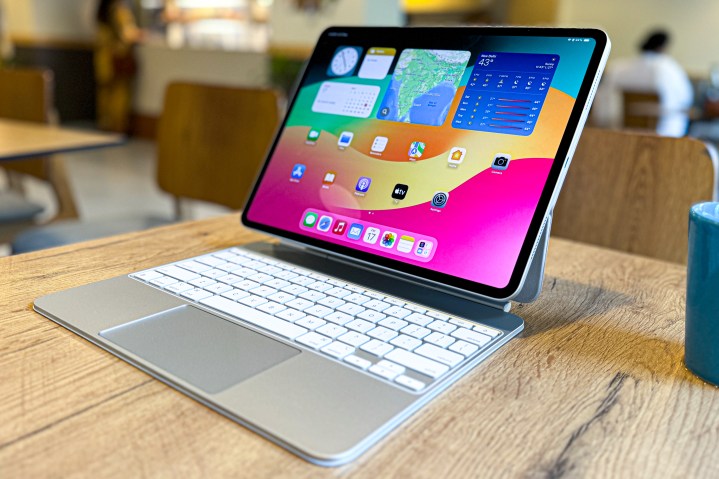
Perhaps the most important difference between the two tablets is their operating systems. That alone could sway you to one device or another.
The Surface Pro runs Windows 11 on ARM, a variant that’s currently optimized exclusively for Qualcomm’s Snapdragon X ARM chipsets. Windows 11 on ARM works just like Windows 11 for Intel, with the exception that apps need to either run natively on the Qualcomm chipset or through emulation. It remains to be seen how well apps run in emulation and how well Windows on ARM supports the variety of peripherals available for Windows 11 on Intel.
The iPad Pro runs Apple’s iPadOS operating system, which is more similar to iOS on the iPhone than macOS on Apple’s MacBooks. It’s a more lightweight operating system optimized for touch, and it lacks the same file management and peripheral support as a full-featured OS while running a completely different set of apps. Everything is optimized for Apple Silicon, however, meaning there’s no concern about how well iPad apps will run on the M4.
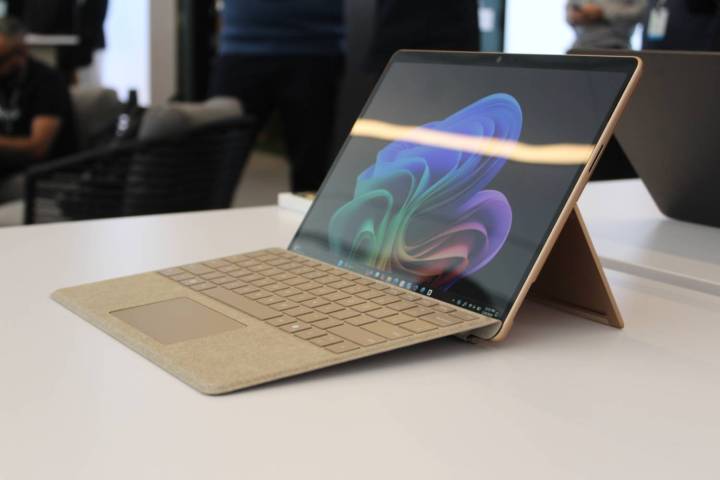
Now that we’ve covered the basic operating system differences, we can discuss the Surface Pro and iPad Pro designs. Of course, they’re both slates, meaning that they’re simply metal chassis fused to glass displays. From the front, the two tablets are similar, with reasonably thin, black display bezels. And to an extent, they’re similar on the back as well, with all-metal surfaces. They come in multiple colors — Platinum, Black, Dune, and Sapphire for the Surface Pro and Silver and Space Black for the iPad Pro. Both are solidly built, with some of the best industrial manufacturing quality available on devices today.
The most important difference is that the Surface Pro includes an integrated kickstand that pulls out from the back and extends from nearly vertical to nearly flat. The iPad Pro does not, making the Surface Pro easier to use on a surface without a keyboard attachment. That also makes the iPad Pro significantly thinner and lighter than the Surface Pro at 0.20 inches and 1.28 pounds for the 13-inch iPad Pro compared to 0.37 inches and 1.97 pounds for the Surface Pro. The 11-inch iPad Pro is 0.21 inches and 0.98 pounds.
The Surface Pro has a new detachable keyboard, the Surface Pro Flex, which can now be used either attached to the Surface Pro or as a standalone Bluetooth keyboard. It offers an angled design for more ergonomic typing, along with a touchpad that’s larger than previous Type Covers and that utilizes a haptic engine. The Apple Magic Keyboard connects magnetically to the iPad Pro and receives power and pairing via the Smart Connector. It holds the iPad Pro at several angles, and the keyboard lies flat. The new Magic Keyboard, available for both the 11-inch and 13-inch models, has a new aluminum keyboard deck and a haptic touchpad.
Ports and connectivity
In terms of connectivity, neither tablet can compare to a typical clamshell laptop. The Surface Pro has two USB4 ports with Thunderbolt 4 support, and a Surface Connect port for power and charging. The iPad Pro has one USB-C port with Thunderbolt 4, which is the only means for charging the tablet. The Surface Pro has external display support for up to three 4K monitors, while the iPad Pro supports just a single attached display. It should be noted that the Magic Keyboard adds a second USB-C port when connected.
The Surface Pro supports the latest Wi-Fi 7 and Bluetooth 5.4 standards, while the iPad Pro is limited to Wi-Fi 6E and Bluetooth 5.3. Both have optional 5G support, via a nanoSIM slot on the Surface Pro and an eSIM with the iPad Pro.
Finally, the Surface Pro has a 1440p front-facing webcam with an infrared camera for Windows 11 Hello facial recognition and a 10.5MP rear-facing camera. The front-facing camera is wide-angle and supports AI features like auto-framing, eye detection, and
The iPad Pro has a 1080p front-facing webcam with Face ID and a 12MP rear-facing camera.
Performance
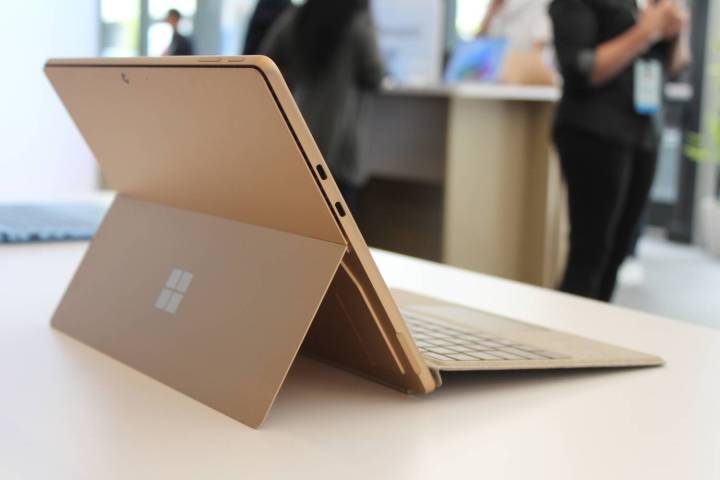
The Surface Pro is now built exclusively around Qualcomm’s new Snapdragon X, an ARM chipset designed specifically for laptop use. There are two versions, the Snapdragon X Plus with 10 CPU cores running at up to 3.4GHz and the Snapdragon X Elite with 12 CPU cores running up to 4.2GHz. The Snapdragon X chipset includes the Adreno GPU. The iPad Pro uses the Apple Silicon M4 chipset, which features either nine or 10 CPU cores and 10 GPU cores.
We haven’t seen benchmarks on products shipping with the Snapdragon X chipset, but it’s likely that the X Elite will be around the same speed as the 10-core M4 and the X Plus around the same speed as the 9-core M4. GPU performance is completely up in the air at this point, although preliminary testing seems to show the M4’s GPU being somewhat faster. Because of the differences between the kinds of apps that run on Windows 11 on ARM versus iPadOS, direct performance comparisons will likely be challenging.
Today, it’s not enough to talk about CPU and GPU performance. With the advent of generative AI and large language models (LLM) upending computing as we know it, the Neural Processing Unit (NPU) that powers these capabilities has taken on a new importance. Apple has had its Neural Engine (NE) in its chipsets for several generations, and the M4 16-core NE boasts 38 trillion operations per second (TOPS). Qualcomm’s Hexagon NPU promises 45 TOPS. Those numbers aren’t carefully defined, however, and so we don’t yet know the actual real-world performance we can expect to see.
Display

The Surface Pro can be configured with either a 13.0-inch 3:2 2.8K (2880 x 1920) IPS display or a 13.0-inch 3:2 2.8K (2880 x 1920) OLED panel, both running at up to 120Hz. The iPad Pro comes with one display in either 11 or 13 inches, and it’s a tandem OLED panel running at 4:3 2420 x 1668 for the 11-inch model and 4:3 2752 x 2064 for the 13-inch model. That makes all displays around the same sharpness, with the iPad Pro having a slightly more square aspect ratio.
We’re certain that the OLED displays will have the same wide and accurate colors as is typical of the technology, along with the usual inky blacks. The most important difference will be brightness, where the Surface Pro’s OLED panel promises up to 800 nits in high dynamic range (HDR) content compared to the iPad Pro’s remarkable 1,600 nits. The iPad Pro’s OLED display is a new tandem design that stacks two OLED panels, using one to provide additional backlighting to the other.
The Surface Pro’s IPS display option is likely to provide better battery life, which would be its primary advantage. It can’t do HDR, though it maxes out at 600 nits of brightness. The iPad Pro is likely to be one of the best devices available today for HDR content.
Portability
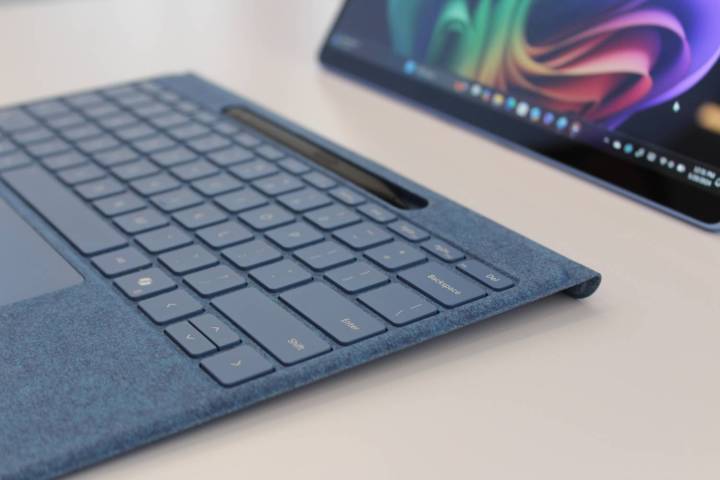
As discussed above, the iPad Pro is remarkably thin and significantly lighter than the Surface Pro. It’s also available in a more compact 11-inch model. That makes the iPad Pro a lot more portable when considering the tablets alone. Adding either tablet’s keyboard accessory will naturally add some thickness and weight. Both are very portable devices that should be easy to use as tablets.
The next important consideration is battery life. Here, we’ll have to go with each manufacturer’s estimates until we have a chance to run our own tests. Notably, both tablets use highly efficient ARM chipsets and so are more equal in this regard than some past comparisons.
According to Microsoft, the Surface Pro will achieve up to 14 hours of local video looping. For the iPad Pro, Apple promises up to 10 hours. The Surface Pro has a considerably larger battery than the iPad Pro, especially in the OLED version, which contributes to the Surface Pro’s added thickness and weight. Therefore, it’s not surprising that it would get better battery life.
We’ll wait to render a verdict
These tablets are both very similar and very different. The Surface Pro runs Windows 11 on ARM, a full-featured OS that’s essentially the same as the one that runs on Windows clamshells and other form factors. The biggest difference will be app compatibility, which remains to be seen. The iPad Pro runs iPadOS, a simpler operating system fully optimized for touch.
The biggest questions revolve around real-world performance and battery life, including when running whatever on-device AI functionality Microsoft and Apple add to their platforms. In the meantime, we’ll wait to see what shakes out before making a firm recommendation.
Editors’ Recommendations

